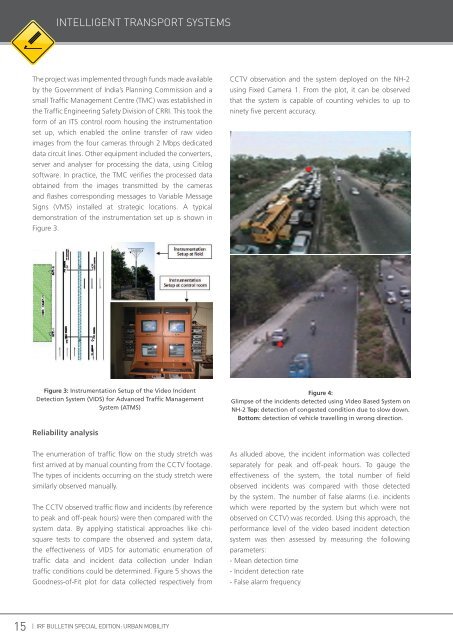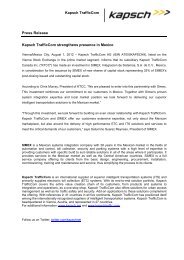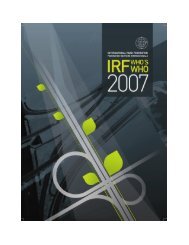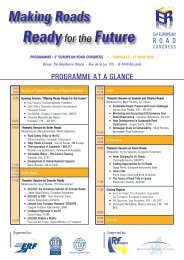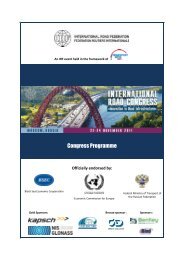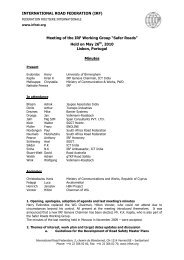Motorways and Urban Mobility - International Road Federation
Motorways and Urban Mobility - International Road Federation
Motorways and Urban Mobility - International Road Federation
You also want an ePaper? Increase the reach of your titles
YUMPU automatically turns print PDFs into web optimized ePapers that Google loves.
15<br />
INTELLIGENT TRANSPORT SYSTEMS<br />
The project was implemented through funds made available<br />
by the Government of India’s Planning Commission <strong>and</strong> a<br />
small Traffic Management Centre (TMC) was established in<br />
the Traffic Engineering Safety Division of CRRI. This took the<br />
form of an ITS control room housing the instrumentation<br />
set up, which enabled the online transfer of raw video<br />
images from the four cameras through 2 Mbps dedicated<br />
data circuit lines. Other equipment included the converters,<br />
server <strong>and</strong> analyser for processing the data, using Citilog<br />
software. In practice, the TMC verifies the processed data<br />
obtained from the images transmitted by the cameras<br />
<strong>and</strong> flashes corresponding messages to Variable Message<br />
Signs (VMS) installed at strategic locations. A typical<br />
demonstration of the instrumentation set up is shown in<br />
Figure 3.<br />
Figure 3: Instrumentation Setup of the Video Incident<br />
Detection System (VIDS) for Advanced Traffic Management<br />
System (ATMS)<br />
Reliability analysis<br />
The enumeration of traffic flow on the study stretch was<br />
first arrived at by manual counting from the CCTV footage.<br />
The types of incidents occurring on the study stretch were<br />
similarly observed manually.<br />
The CCTV observed traffic flow <strong>and</strong> incidents (by reference<br />
to peak <strong>and</strong> off-peak hours) were then compared with the<br />
system data. By applying statistical approaches like chisquare<br />
tests to compare the observed <strong>and</strong> system data,<br />
the effectiveness of VIDS for automatic enumeration of<br />
traffic data <strong>and</strong> incident data collection under Indian<br />
traffic conditions could be determined. Figure 5 shows the<br />
Goodness-of-Fit plot for data collected respectively from<br />
| IRF BULLETIN SPECIAL EDITION: URBAN MOBILITY<br />
CCTV observation <strong>and</strong> the system deployed on the NH-2<br />
using Fixed Camera 1. From the plot, it can be observed<br />
that the system is capable of counting vehicles to up to<br />
ninety five percent accuracy.<br />
Figure 4:<br />
Glimpse of the incidents detected using Video Based System on<br />
NH-2 Top: detection of congested condition due to slow down.<br />
Bottom: detection of vehicle travelling in wrong direction.<br />
As alluded above, the incident information was collected<br />
separately for peak <strong>and</strong> off-peak hours. To gauge the<br />
effectiveness of the system, the total number of field<br />
observed incidents was compared with those detected<br />
by the system. The number of false alarms (i.e. incidents<br />
which were reported by the system but which were not<br />
observed on CCTV) was recorded. Using this approach, the<br />
performance level of the video based incident detection<br />
system was then assessed by measuring the following<br />
parameters:<br />
- Mean detection time<br />
- Incident detection rate<br />
- False alarm frequency


